A recent study at the University of Gothenburg found that nearly 5% of 70-year-olders have glaucoma, a common eye condition that can damage vision. What’s concerning is that half of those with glaucoma didn’t even know they had it.
Glaucoma is a severe eye disease that harms the optic nerve and can, in extreme cases, lead to blindness. Lena Havstam Johansson, a Ph.D. student at the University of Gothenburg and a nurse at Sahlgrenska University Hospital, conducted the research. Among the 560 participants examined by eye specialists, 4.8% had glaucoma.
Lena Havstam Johansson said, “Of those diagnosed with glaucoma via the study, 15 people – or 2.7% of all participants – were unaware that they had the disease before being examined. So half of those who turned out to have glaucoma were diagnosed because they took part in the study.”
For those newly diagnosed, this discovery allowed them to begin treatment with daily eye drops that reduce eye pressure and slow down optic nerve damage.
Surprisingly, people with glaucoma, a vision-affecting disease, lead similar lifestyles to those without it. They engage in similar physical activity levels, don’t smoke or drink more, and rate their overall quality of life as good. They also don’t feel more tired or depressed.
This discovery may comfort those with glaucoma, as living with a vision-impairing disease can be challenging. However, it’s important to note that people with glaucoma did report a lower quality of life-related to their vision. They mentioned difficulties with tasks like climbing stairs, seeing at night and noticing things in their peripheral vision. This can lead to social isolation and a loss of independence, causing frustration and limitations in daily life.
Researchers conducted a study as part of the H70 study, which examined the health of older people in Gothenburg for 50 years. They invited 1,203 individuals born in 1944 for comprehensive physical and cognitive tests. Among them, 1,182 answered questions about their eye health and family history of glaucoma, and eye specialists examined 560 at Sahlgrenska University Hospital.
The findings confirm that genetics play a role in glaucoma, as those with the condition were likelier to have close relatives with it. Glaucoma typically involves higher eye pressure, but interestingly, 67% of newly diagnosed individuals had normal eye pressure.
In the early stages, the healthy eye can compensate for vision loss, making it challenging to detect glaucoma. The research shows that glaucoma often doesn’t initially affect visual acuity, making it harder to spot.
These results have been published in two articles in the journal Acta Ophthalmologica.
The study’s findings emphasize the importance of regular eye check-ups, especially for older individuals. Glaucoma can develop without significant symptoms, leading to undiagnosed cases. Early detection and intervention can help manage the condition and prevent potential vision loss.
While glaucoma may not initially affect visual acuity, it is crucial to address the disease promptly to maintain eye health and overall quality of life. Awareness of the hereditary factors and variations in eye pressure associated with glaucoma can aid in early identification and management.
Journal Reference:
- Lena Havstam Johansson, Lada Kalaboukhova, et al., The prevalence of glaucoma in a 70-year-old Swedish population in the city area of Gothenburg. Acta Ophthalmologica. DOI: 10.1111/aos.15734.
- Lena Havstam Johansson, Lada Kalaboukhova. Vision-related quality of life among 70-year-olds diagnosed with glaucoma. Acta Opthalmologica. DOI: 10.1111/aos.15737.
